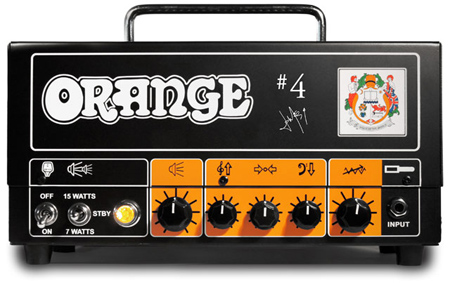Review: Orange Signature #4 Jim Root Terror Amp Head

The following content is related to the October 2012 issue of Guitar World. For the full range of interviews, features, tabs and more, pick up the new issue on newsstands now, or in our online store.
The lunchbox-size-amp revolution continues to thrive and evolve, and once again Orange leads the way by offering the first artist model in this increasingly cool category of guitar products. The Orange Signature #4 Jim Root Terror head is the third-generation evolution of the company’s Tiny Terror Series, which started with the original Tiny Terror and progressed with the high-gain Dark Terror. Whereas the Dark Terror was based on the high-gain tones of Orange’s Thunder series, the Jim Root Terror is modeled after the Dirty channel of the Rockerverb 100, which has formed the bedrock of Root’s sound with Slipknot and Stone Sour.
FEATURES
Like the Tiny Terror and Dark Terror, the Jim Root Terror is a single-channel 15-watt amp. Also like those amps, the Dark Terror is powered by a pair of EL84 tubes and uses three 12AX7s in the preamp section and a single 12AT7 for the effect loop. The most welcome feature of the Jim Root Terror (and a first for the Tiny Terror Series) is the three-band EQ (bass/middle/treble) section, which offers considerably more tonal-shaping capabilities that the single tone/shape control on the previous models. Other controls include volume and gain knobs, a switch for selecting 15 or seven watts of output, effect loop send and return jacks on the rear panel, and three 1/4-inch speaker output jacks (two eight-ohm and one 16-ohm).
PERFORMANCE
As one might expect, the Jim Root Terror’s three-band EQ section provides significantly different tonal character than that of its predecessors. While the amp produces more than sufficient gain, the EQ has a mighty midrange roar and growl that makes it sound more like a hot-rodded Seventies amp than a modern metal monster. The amp doesn’t produce quite enough bottom-end wallop to convince guitarists that they’re playing through a larger head, but with all controls full out it’s still hard and heavy enough for many metal styles.
Even better, the amp responds quite nicely when you donkey punch it with an overdrive, distortion, boost or graphic EQ pedal, taking the extra aggression in stride while retaining its signature character. With delay or reverb patched into the effect loop, the tones are positively studio or stadium worthy, and if your band has a rhythm guitarist to handle the ultralow frequencies, it’s not much of a stretch for a lead guitarist to gig with this amp by miking the Terror played through a 2x12 or 4x12 cabinet.
Get The Pick Newsletter
All the latest guitar news, interviews, lessons, reviews, deals and more, direct to your inbox!
Chris is the co-author of Eruption - Conversations with Eddie Van Halen. He is a 40-year music industry veteran who started at Boardwalk Entertainment (Joan Jett, Night Ranger) and Roland US before becoming a guitar journalist in 1991. He has interviewed more than 600 artists, written more than 1,400 product reviews and contributed to Jeff Beck’s Beck 01: Hot Rods and Rock & Roll and Eric Clapton’s Six String Stories.
“The world’s most convenient all-tube amp head”: Steve Vai-backed firm Synergy has unveiled a tiny amp head that lets you swap in tones from some of the world’s biggest amp builders
“Modified connects us with a long-standing tradition of modifying Marshall amps that dates back to the 1970s”: Marshall unveils factory modded takes on the 1959 Plexi and JCM800 – tipping its cap to the amp wizards of rock’s golden era










